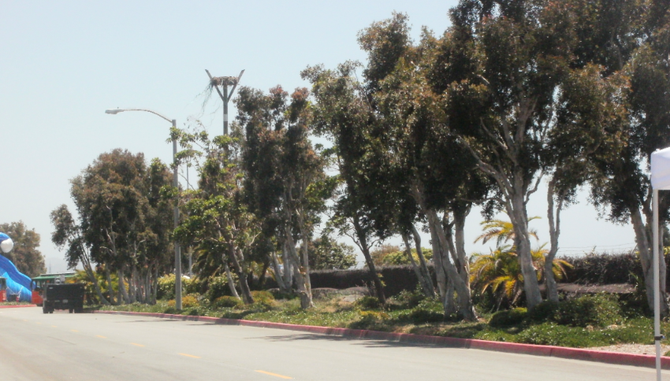 Facebook
Facebook
 X
X
 Instagram
Instagram
 TikTok
TikTok
 Youtube
Youtube

The two manmade platforms in the port area of National City are home to young osprey this year — for at least the third time in the past five years. There are two chicks on the platform near Pepper Park and at least one on the platform near the Port Terminal, port workers say.
The San Diego Unified Port District built the platforms — a total of five, including others on Shelter Island and in Imperial Beach and Chula Vista — for the raptors after port workers noticed the birds were building nests and laying eggs on light poles. Those egg-laying adventures often ended disastrously with the eggs broken on the ground, according to port spokeswoman Marguerite Elicone.
"The port put the osprey nesting platforms there so they would have a safe place to breed and hatch their young," she said.
Osprey have a nearly six-foot wingspan and eat mostly fish. While they are not a threatened or endangered species, their eggs were made fragile by pesticides including DDT. They are protected under the Migratory Bird Treaty Act of 1918. The birds mate for life and their critical breeding period is from March 15 to August 15, according to the state Department of Fish and Wildlife.
The five platforms cost about $5000 to design, build, and install and serve a valuable purpose for port tenants as well as the birds, Elicone said.
"They scare away the seagulls and that keeps bird poop off the cars that come into our port and are parked near the terminal," she said.


The two manmade platforms in the port area of National City are home to young osprey this year — for at least the third time in the past five years. There are two chicks on the platform near Pepper Park and at least one on the platform near the Port Terminal, port workers say.
The San Diego Unified Port District built the platforms — a total of five, including others on Shelter Island and in Imperial Beach and Chula Vista — for the raptors after port workers noticed the birds were building nests and laying eggs on light poles. Those egg-laying adventures often ended disastrously with the eggs broken on the ground, according to port spokeswoman Marguerite Elicone.
"The port put the osprey nesting platforms there so they would have a safe place to breed and hatch their young," she said.
Osprey have a nearly six-foot wingspan and eat mostly fish. While they are not a threatened or endangered species, their eggs were made fragile by pesticides including DDT. They are protected under the Migratory Bird Treaty Act of 1918. The birds mate for life and their critical breeding period is from March 15 to August 15, according to the state Department of Fish and Wildlife.
The five platforms cost about $5000 to design, build, and install and serve a valuable purpose for port tenants as well as the birds, Elicone said.
"They scare away the seagulls and that keeps bird poop off the cars that come into our port and are parked near the terminal," she said.
Comments